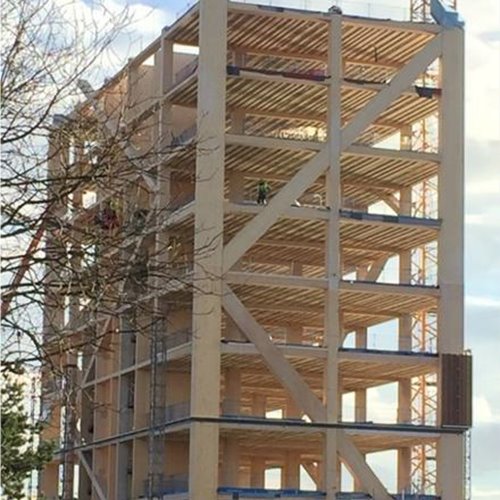 Improving the durability performance of engineered wood products: A study tour of Europe and North America
Improving the durability performance of engineered wood products: A study tour of Europe and North America
William Leggate - 2017
Engineered wood products (EWPs) are
rapidly growing global market share in both structural and appearance
end-uses. These products are formed by combining wood components such as
flakes, fibres, particles, veneers, strands, rounds or sawntimber into
composite products. Often these composite products can also feature
non-wood components such as glues, metals and plastics. Examples of EWPs
include cross laminated timber (CLT), glulam, plywood, laminated veneer
lumber (LVL), oriented strandboard (OSB), particleboard and I beams.
These products are used in diverse applications, including construction,
flooring, walls, roofs, linings, decorative architectural features,
furniture, packaging, utility poles, cross-arms and bridges. The reasons
for their growing popularity are multi-faceted and include numerous
performance, resource conversion and sustainability advantages.
However, as the use of EWPs expands, so too do concerns about their
long-term durability performance. This report describes the outcomes of a
study of EWP production, use and R&D in Europe and North America
with a special focus on wood protection measures adopted to maximise EWP
durability performance. The current status quo and implications for the
Australian industry are also described.
Key findings are:
- Because EWPs contain wood, they are subject to the same deterioration
agents that effect all wood products. This includes damage by fungi,
insects, fire and weathering. However, the impact of these degradation
agents on EWPs is not always the same as for solid wood products. This
is because EWPs also usually contain glue and have different geometries
and configurations compared to solid wood products. Additionally, the
manufacturing process adopted for some EWPs involving log
pre-conditioning, high temperature and pressure during product forming
and pressing can also impact on EWP durability.
- The vast majority of EWPs in Europe and North America are not
preservative treated and are used internally or in weather-protected
situations. However, EWPs are preservative treated if used in exposed,
hazardous situations requiring longer service lives or in some cases,
for particular applications, if exported to countries such as Australia.
- The main focus of the wood preservative treatment industries of Europe
and North America is currently solid wood products, not EWPs.
- There is a greater reliance on design, construction, detailing,
finishing, maintenance and monitoring approaches rather than wood
preservative treatment to maximise durability performance of EWPs.
However, there is an increasing call to mandate preservative treatment
of EWPs such as CLT and other massive timber elements where they are
used as structurally critical elements and in difficult to access
situations. This is because it is acknowledged that there are often
failures in the above-mentioned control measures and precautionary
treatments would help to avoid the serious, potentially catastrophic
consequences of EWP failure.
- Various preservative treatment methods are adopted for EWPs including:
- Treatment of feedstock before gluing and product manufacture
- Treatment during product manufacture
- Treatment after product manufacture
- Combinations of the above
- There is increasing global pressure to reduce the use of biocides, and
concerns over growing restrictions which will limit future availability
of wood preservatives that are currently in use. This is particularly
the case in Europe. For this reason, wood preservation R&D in Europe
is predominantly concerned with wood modification and novel
alternative, non-biocidal treatment measures.
- In Europe and North America, weathering degrade of wood products is a
major concern and there is a greater focus than in Australia on
finishing systems to reduce wood degradation (e.g. from weathering and
decay) and to maximise the appearance performance and aesthetic appeal
of wood products.
- Globally, changing climatic conditions are projected to increase wood
degradation hazards and concomitantly raise the importance of R&D to
provide solutions.
- EWP producers recognise the potential to greatly expand their
market-share if more optimal and affordable wood protection options can
be found.
Download Report